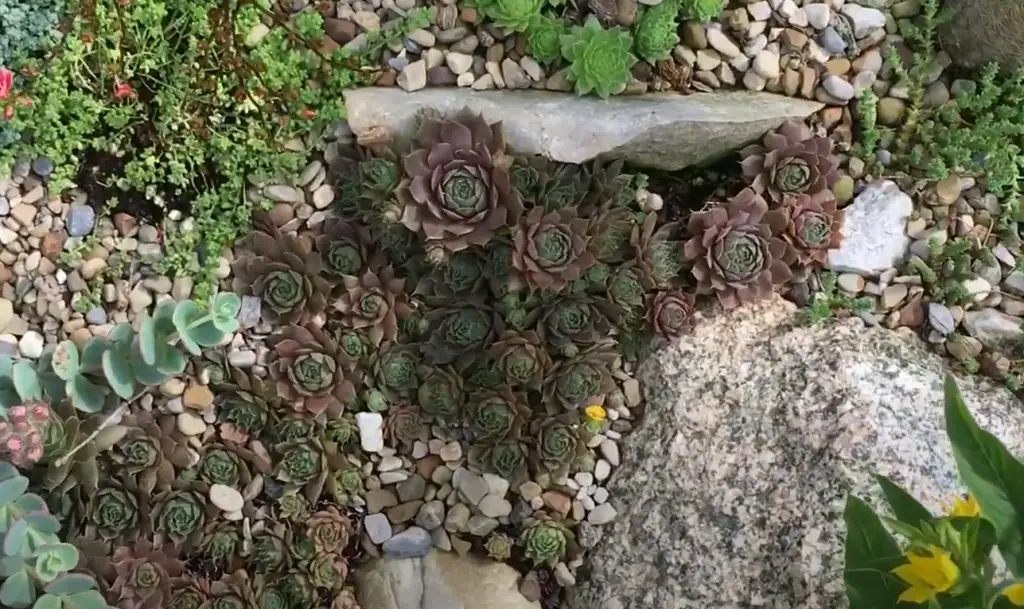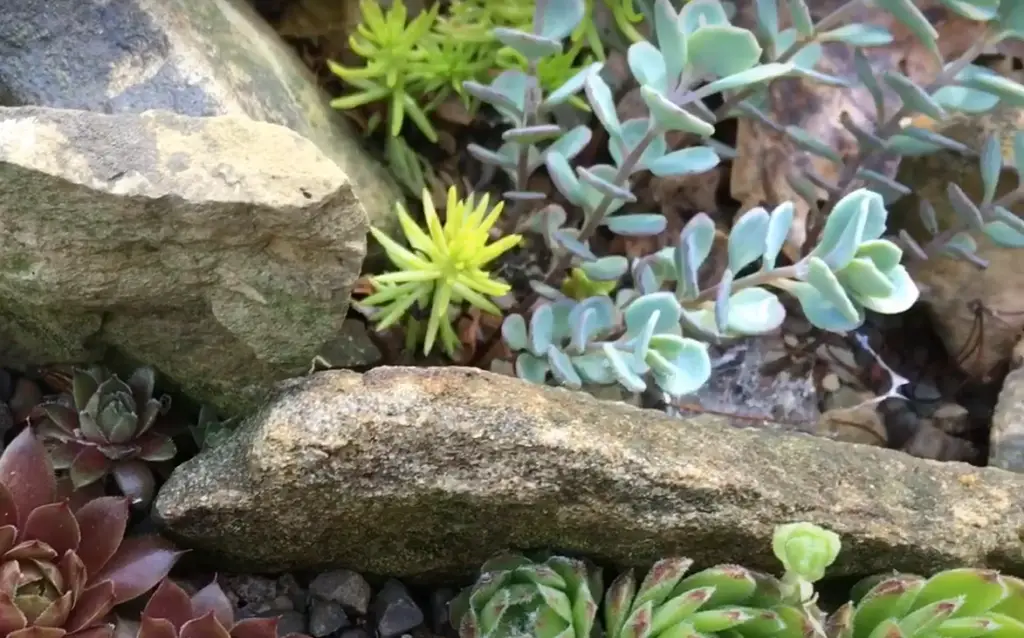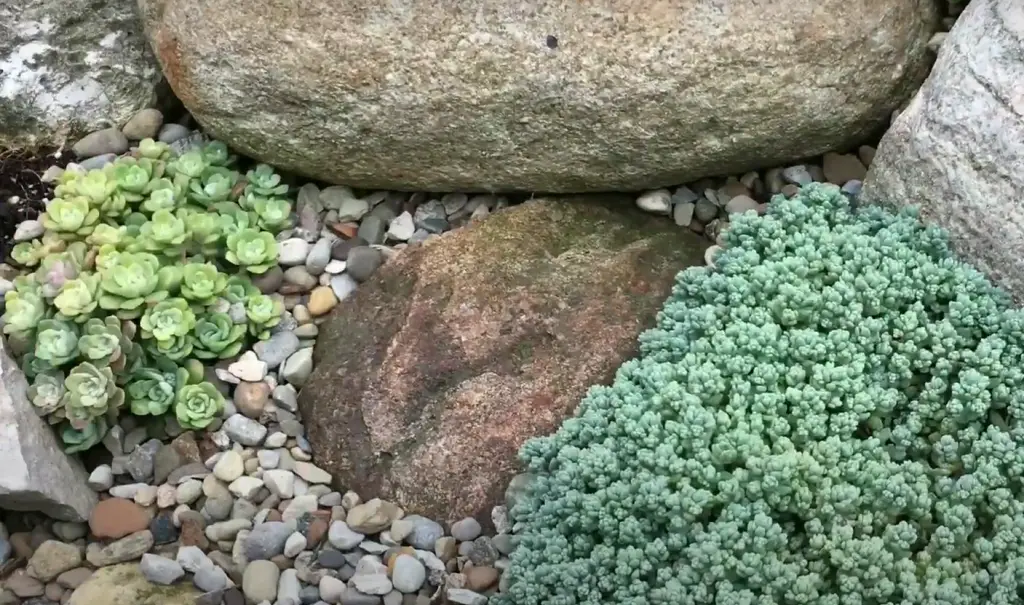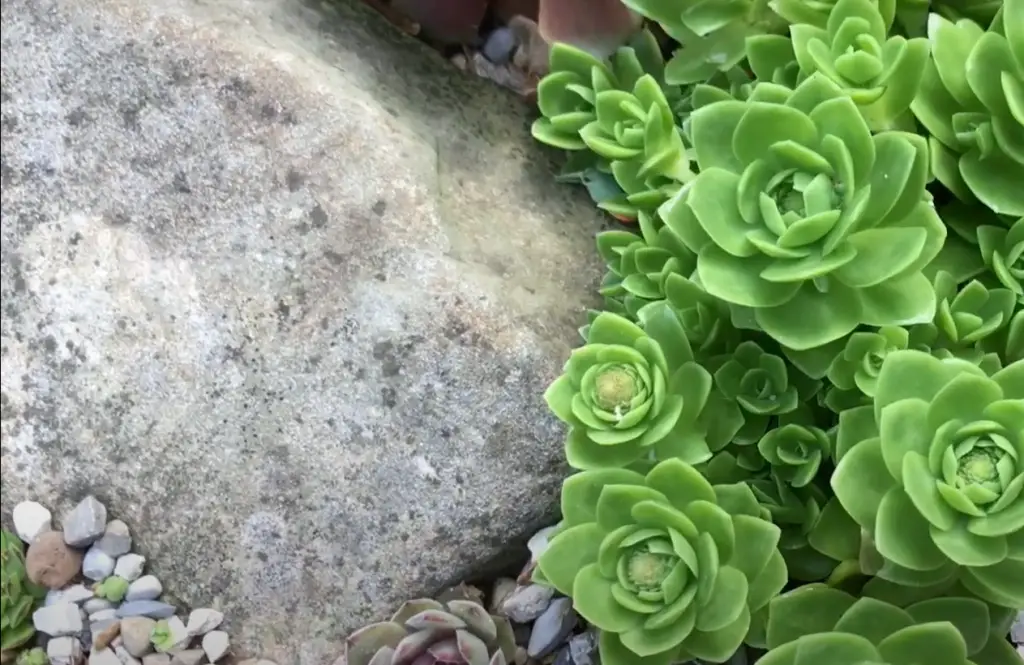Are you looking for the perfect way to spruce up your outdoor living space? Sedum gardens are a creative and fun way to add some pizzazz to your patio, balcony, or other area.
They’re easy to install and require minimal upkeep, making them ideal for homeowners who don’t have time or money to invest in a larger garden project.
With these sedum garden ideas, you can create an aesthetically pleasing focal point that will make everyone who visits jealous of your gardening skills!
Sedum Garden Ideas
Plant Sedum Along Walkways or Between Stepping Stones
This is a great way to create a pathway that not only looks beautiful, but helps reduce weeds.

Sedum is a low-growing succulent and makes an excellent border or edging around garden areas. Plant the sedums at least 6 inches apart to give them plenty of room to spread out.
Create Mini Outdoor Rooms with Sedum
Plant sedum around your patio or deck. Use big kinds for walls and benches, and small kinds for ground cover.
Add colourful annuals between the sedums to make it look nice. This will create a cosy outdoor room.
Plant Sedum Along Driveways and Walkways
Sedums make excellent edging plants along driveways or pathways. They look good, require little maintenance, and attract wildlife to your yard.
Use Sedum in Container Gardens
Fill containers with a mix of sedums and other plants. Try planting low-growing sedum varieties along the edges of the container for contrast.
You can also add taller types to provide an upright background for the others. Place them in a sunny spot and water regularly.
Install Sedum as a Low-Water Ground Cover
Sedum is extremely drought tolerant and makes a great ground cover in areas that don’t get enough water.
Plant the sedums in groups of three or four for maximum coverage. Add smaller varieties between them for contrast.
Plant Sedum Around Trees
Plant sedums around the base of smaller trees or shrubs to help protect their roots from extreme temperatures. This will also make your yard look neat and tidy. Plant low-growing varieties for best results.
Install a Green Roof with Sedum
Green roofs are becoming increasingly popular, and sedums make an excellent choice for this type of project.
Sedums require little maintenance, tolerate extreme temperatures, and look great. Install a green roof over your patio or deck to create a unique outdoor space.
Plant Sedum Around Your Pool Deck
Sedums make a great low-maintenance alternative to grass around your pool deck. Plant them in large groups for maximum coverage and be sure to add some colorful annuals between the plants for contrast. The sedums will also help keep weeds at bay.
Use Sedum to Add Color to Rock Gardens
Sedum plants can make your rock garden look more colorful. The ‘John Creech’ and ‘Dragon’s Blood’ types are the best for this. Plant three or four together and put smaller plants between them. They also help to keep weeds away from your rocks.
Replace Your Natural Grass Lawn with Sedum
Sedum can make an excellent grass replacement. Plant low-growing types and be sure to space them 6 inches apart for maximum coverage.
Add some annuals between the sedums for a pop of color and enjoy your low maintenance lawn!
Plant Sedum in Borders and Islands to Add Color to Your Low-Water Landscaping
Sedums come in many colors and sizes, so you can create a beautiful border or island with them.
Plant taller varieties along an edge for contrast, and use low-growing types between them. This will help keep weeds away and add color to your landscape.
Add Colour with Annuals
If you want to add a bit of colour to your sedum garden, consider adding some short-lived annuals. These will give you a burst of colour every year and can be changed up every season.

Plant the annuals between the sedums and add mulch around them to help keep weeds away.
Use Sedum as Ground cover
Sedums are ideal for groundcovers. They’re low-maintenance and require less water than grass.
Plant sedum varieties of various heights and colours to create a unique look in your garden. And because they spread so quickly, you don’t have to worry about weeds taking over.
Make Use of Vertical Space
Sedums can also be used in vertical gardens. Plant them along the sides of your house or fence to add color and texture to your landscape.
You can even hang baskets from a trellis and fill them with your favourite sedums for an eye-catching display.
Create Living Walls with Sedums
You can create beautiful green “living walls” with sedum. These walls are great for outdoor spaces that need a bit of privacy or some extra color. Simply install the panels and fill them with your favourite sedum varieties.
Create an Eye-Catching Focal Point
If you want to draw attention to a specific area in your garden, consider planting sedums in a unique pattern.
Plant tall varieties in a circle or a rectangle and fill the interior with smaller sedums for contrast. This will create an eye-catching focal point that will really make your garden pop!
Design with Texture in Mind
When planting sedums, make sure to consider their texture. Plant short and tall varieties together for a natural look, or use the same type of plant with different shades of green or purple for a more uniform appearance.

Sedums come in many shapes, sizes, and colors, so you can create any kind of look you want.
Use Sedums to Soften Hardscapes
Sedums are great for softening hardscapes like driveways and walkways. Plant some of your favourite low-growing varieties between the stones or bricks and you’ll have a beautiful, easy-to-maintain pathway in no time. The plants will also help to keep weeds away.[1]
FAQ
What plants go well with sedum?
Sedums work well with many other plants, including annuals and perennials. Consider adding some colorful annuals between the plants for contrast, or use low-growing perennials to create a lush groundcover.
How do I care for sedum?
Sedums are very easy to care for. They require minimal water and can tolerate drought conditions.
Can I use sedums in containers?
Yes, sedums are perfect for containers! Plant some low-growing varieties in a pot or hanging basket on your porch or patio for a lush and colorful display. You can also mix different sedums together for even more interest.
How do you landscape with sedum?
There are many ways to use sedums in your landscaping. You can create borders, islands, living walls, and more with this versatile plant.
Consider planting taller varieties along an edge for contrast, or use low-growing types between them for a lush look. You can also add annuals between the plants for bursts of color or mix different sedums together for added interest.
How do you make a sedum garden?
Creating a sedum garden is easy! Simply choose the varieties you like and plant them in well-draining soil. Place taller plants along the edges for contrast and use smaller ones between them for a lush look.

You can also add some annuals to create pops of color, or mix different sedums together for even more interest. Finally, give the plants plenty of water and sunlight to keep them healthy.
Where is the best place to grow sedum?
Sedums are very versatile plants, so you can grow them almost anywhere! They prefer full sun, but they will tolerate partial shade. Plant them in well-draining soil and make sure to water them regularly for best results.
You can also grow sedums in containers or hanging baskets if you don’t have a lot of space.
Can sedum survive winter?
Yes, most sedums are hardy enough to survive the winter. They may die back in cold climates, but they will come back in the spring.
To help them survive the cold months, make sure to mulch around the plants to protect their roots and water them before frost hits.
Does sedum spread quickly?
Yes, some types of sedum can spread quickly. These varieties should be planted in a contained area to prevent spreading. Other varieties are more controllable and will not spread as quickly.
Be sure to do your research before planting to make sure you choose the right type for your garden.
What are the benefits of planting sedum?
Sedums are great for many reasons. They are low-maintenance and drought-tolerant, so you don’t have to water them often.
They also make a great ground cover and help to keep weeds away. Plus, they come in many shapes, sizes, and colors so you can create any kind of look you want.
What other tips should I know about sedum?
Sedums do best in well-draining soil and full sun, but they can tolerate some shade. They are very easy to care for, so you don’t have to worry about spending a lot of time tending to them.
Just make sure to water them regularly and mulch around the plants in cold climates to help them survive the winter.
You should also be aware that some varieties spread quickly, so be sure to plant them in a contained area if you don’t want them taking over your garden.
What other plants do well with sedum?
Sedums pair nicely with many plants and can be used to create a stunning display. Consider planting low-growing perennials like creeping thyme, hosta, or violets between the sedums for a lush look.

You can also add some annuals or shrubs around the edges for contrast. Make sure to mix different colors, shapes, and sizes for a beautiful design!
What is the best way to care for sedum?
The best way to care for sedums is to give them plenty of sun and well-draining soil. Water them regularly, but be careful not to overwater as this can cause root rot or fungal diseases.
Mulch around the plants in cold climates to help protect the roots and stalks from frost. Finally, trim back the plants in late winter or early spring to help promote new growth.
How can I prevent sedum from spreading?
If you’re worried about your sedums spreading too quickly, there are a few things you can do. Plant them in a contained area such as a raised bed or container and make sure the soil is well-draining.
You can also try using ground covers to fill in any gaps between the plants to help contain them. Finally, trim back the sedums in late winter or early spring to keep them from taking over your garden.
How do I know which type of sedum to plant?
The best way to determine which type of sedum is right for your garden is to research the different varieties. Consider factors such as climate, soil type, and available space before choosing a variety.
Some types are better suited for certain climates or soils than others, so be sure to pick the one that best suits your needs.
What pests and diseases affect sedum?
Sedums are generally resistant to many pests and diseases, but some can still be affected.
Diseases such as powdery mildew, rust, and root rot can also affect sedums. To prevent these, make sure to water plants at their roots instead of overhead and prune or thin out any overcrowded areas.
How often should I water sedum?
Sedums are drought-tolerant and don’t require a lot of water. Generally, they only need to be watered when the soil is dry. If you’re in an area with low rainfall, you may need to water your plants once or twice a week during hot summer months.
In colder climates, only water when the soil is completely dry and use mulch around the plants to help retain moisture.
How can I add color to my sedum garden?
Sedums come in a variety of colors and textures, from soft greens to deep purples. You can mix and match different varieties for a more vibrant look or opt for one monochromatic hue for a contemporary design.
Adding other foliage plants such as ornamental grasses, ferns, or even small shrubs can also add interest to your garden. For a pop of color, consider planting some annuals like petunias or marigolds around the edges of your sedum garden.
How do I enhance the texture of my sedum garden?
Adding different textures is an easy way to give your sedum garden a unique look. Consider planting low-growing perennials like creeping thyme, hosta, or violets between the sedums for added interest.

You can also mix in some ornamental grasses, ferns, or small shrubs for contrast. For a bold look, consider adding large-leaved foliage plants or even topiary sculptures to your garden design.
Why should I add mulch to my sedum garden?
Adding a layer of mulch around your sedums is beneficial in a variety of ways. It helps protect the roots from extreme temperatures, keeps weeds at bay, and retains moisture in the soil so you don’t have to water as often.
It also adds nutrients to the soil and can even help reduce erosion. When choosing a mulch, opt for something organic such as wood chips or bark to give your garden an extra boost of nutrients.
Why should I trim back my sedum plants?
Trimming back sedums in late winter or early spring helps promote new growth and can keep them from spreading too quickly. It also encourages larger blooms and can help improve the overall health of your plants.
When trimming, be sure to use sharp garden shears and make clean cuts at a 45-degree angle, cutting just above the leaf nodes.
Does sedum attract wildlife?
Yes! Sedums are a great way to bring wildlife into your garden. The flowers provide nectar and pollen for bees, butterflies, and other pollinators, while the leaves provide food for caterpillars and other larval stages of some insects. You may even find small lizards or birds taking refuge in your sedum garden!
Does sedum need to be fertilised?
In most cases, sedums don’t require additional fertilizers. They are naturally low-maintenance plants and do well in a variety of soils.
If your soil is particularly poor or you want bigger blooms, adding a balanced fertilizer once or twice a year can help boost growth and promote healthier plants.
You should only fertilize during the active growing season and never when the plant is dormant.
Do sedum plants have any pests?
Though sedums are generally resistant to most diseases and pests, there may be a few that affect them. Aphids, caterpillars, slugs, and snails can all cause damage to your plants, so it’s important to keep an eye out for these common garden pests.
If you see any signs of damage, you can use an organic insecticide or simply handpick the pests off the plants.
Does sedum need to be divided?
If your sedums are looking overcrowded or you want to propagate new plants, dividing them every few years can help.
When dividing, gently dig up the plant and separate the root ball into two or three sections. Replant each section in well-draining soil, water thoroughly, and mulch around the base of the plants. With proper care, your sedum garden will be thriving in no time!
Do sedums need a lot of sun?
Yes, most sedums prefer full to partial sun. They can tolerate some shade but may not produce as many blooms. When planting, be sure to place them in an area that gets at least six hours of direct sunlight per day for best results.
Does deadheading help keep sedums blooming longer?
Deadheading is the process of removing spent or wilted flowers from your plants. This helps promote new growth and can encourage your sedum to continue blooming for an extended period of time.
To deadhead, simply pinch off the faded flower heads with your fingers or use a pair of sharp garden shears.
Are sedums easy to take care of?
Yes! Sedums are low-maintenance plants that require minimal effort to keep them thriving. Water when the soil is dry and apply a light fertilizer during the active growing season.

Trim back any overgrown stems in late winter or early spring and add a layer of mulch to help keep the soil moist and free from weeds. With a little bit of love and care, you’ll soon have a beautiful sedum garden!
Do sedums need to be watered regularly?
Sedums don’t require a lot of water and can survive in dry conditions. However, they do benefit from occasional watering during the active growing season.
Be sure to check the soil before you water and only water when it’s completely dry. Too much moisture can lead to root rot and other diseases.
Can sedums grow indoors?
Yes, though they may not do as well indoors as they do outdoors in the garden. When growing indoors, it’s important to provide bright light and good air circulation. You should also use a potting soil specifically designed for succulents.
Which type of soil is best for growing sedums?
Sedums prefer well-draining soils, such as a cactus mix or sandy loam. If you’re using regular potting soil, be sure to add extra perlite or pumice to help increase drainage and aeration.
Adding a layer of mulch around the base of the plants can also help retain moisture and block out weeds.
Which varieties of sedums are most popular?
Popular varieties of sedum include Autumn Joy, Dragon’s Blood, and Black Jack. These plants are drought tolerant, easy to care for, and produce beautiful blooms in shades of pink, red, yellow, and white. Other popular varieties include Blue Spruce, Angelina Stonecrop, and Matrona.
Do sedums need to be fertilized?
Yes, it’s important to provide your plants with the nutrients they need in order to thrive.
Fertilize during the active growing season and never when the plant is dormant. Choose an organic fertilizer that’s specifically made for succulents and follow the application instructions on the label.
Are sedums good for attracting pollinators?
Yes! Sedums are great plants for attracting bees, butterflies, and other beneficial insects to your garden. The colorful blooms of these plants provide a food source for pollinators while also adding beauty and interest.
If you want to attract even more pollinators, plant a variety of flowering plants to provide different sources of nectar.
Are sedums good for landscaping?
Yes! Sedums are widely used in garden design and landscaping due to their low-maintenance nature and attractive blooms.
They are perfect for rock gardens, pathways, flowerbeds, or container gardens. With a little bit of creativity, you can create an eye-catching display with these hardy plants.
Can sedums be grown from seed?
Yes! Sedums can be grown from seeds, though it’s usually easier to start with a young rooted cutting. Soak the seeds in water overnight and then plant them in well-draining soil.
Keep the soil moist and provide plenty of light for best results. It may take several weeks for the seeds to germinate.
Do sedums need to be deadheaded?
Deadheading is not necessary for most types of sedums, though it can help promote further blooming and extend the flowering period.
If you do choose to deadhead, make sure to remove only the faded flower heads as this will encourage new buds to form.
Useful Video: How I Built My Cold Hardy Succulent Rock Garden (Sempervivum Sedum Orostachys) – Weed Barrier?
Conclusion
Having a sedum garden can be a great way to introduce easy-to-maintain greenery into your backyard or balcony. From colorful rock path settings to cascading containers, you have plenty of options for designing and growing sedums outdoors.
Not only are they effortless to grow, but they also provide diverse forms of protection in the garden from groundcover to attractive foliage.
What’s more, sedums come with many desirable characteristics like drought tolerance and low maintenance requirements that make them an ideal choice for those seeking something beautiful yet low effort.
You can make your home look beautiful and artistic with these ideas. Try it out! When you add green things to your space, it looks amazing and everyone will love it. Start growing sedums right away – they will give you lots of rewards.
References:
- https://www.installitdirect.com/learn/sedum/










Leave a Reply
View Comments